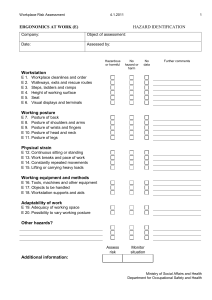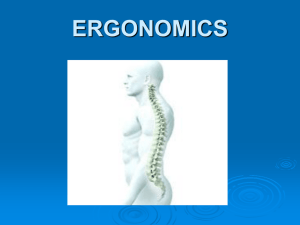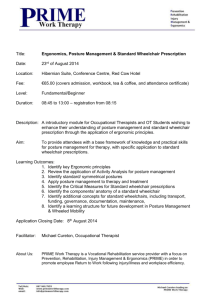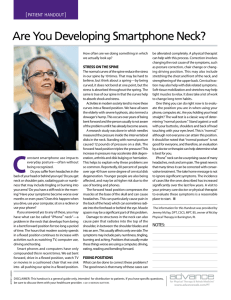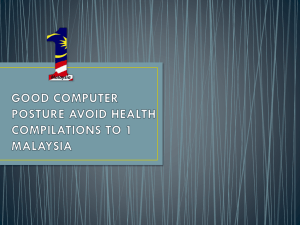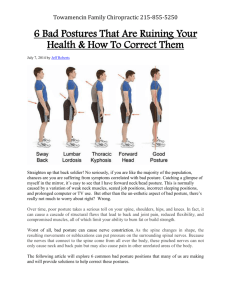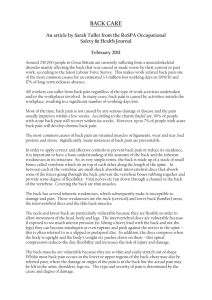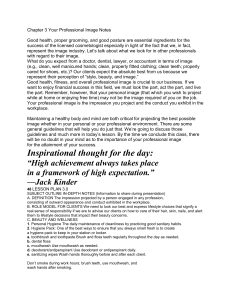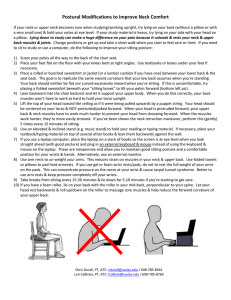Presentation - June 13, 2012
advertisement
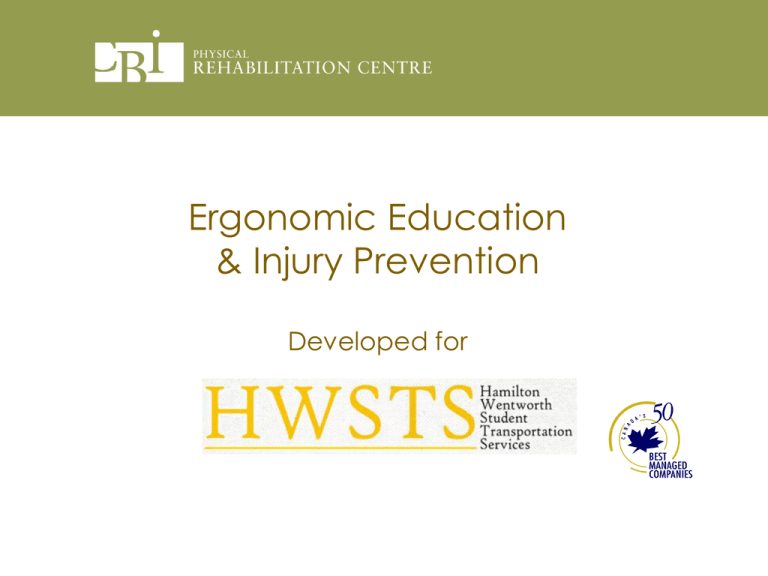
Ergonomic Education & Injury Prevention Developed for Agenda Reason for today’s visit Who am I? Causes of Injuries Ergonomics Injury prevention Apply the principles Reason for My Visit Ergonomics How can we prevent Musculoskeletal injuries? • • • • • Organization of work flow Job Design/Redesign (this includes the environment) Ergonomic Education Training Physical Conditioning & Lifestyle Who am I? Registered Occupational Therapist • • • Promoting health and wellbeing through activity engagement Solve problems that interfere with your life Ergonomics CBI Health Team • • • • • Occupational Therapist Physiotherapist Chiropractor Massage Therapist Kinesiologist Causes of Injuries Stress beyond what your body can handle • Sustained Posture • Awkward Posture • High Repetition • High Force Static Stress = Muscle Fatigue Ergonomics Ergonomics is a science concerned with the ‘fit’ between people and their work: ensuring that the job gets done with the least strain on the person doing it. Anatomy 101: Trunk & Spine Muscles of the front and back support us: Abdominal muscles and flexible back and leg muscles help maintain good posture. Muscles across the chest, shoulder blades and neck support the arms & back. Slouching increases fatigue and makes all the structures work harder to support the back. Good posture involves training your body to stand, walk, sit and lie in positions where the least strain is placed on supporting muscles and ligaments during movement or weight-bearing activities. Common Posture Positions: 1. 2. 3. 4. 5. Sway back Lumbar Lordosis Thoracic Kyphosis Forward Head Good Posture Static Sitting Maintain the spine’s neutral curves Chair with a lumbar support Seat should be flat or tilted forward slightly Bend from the hips when leaning forward Knees at or above hip level Neutral Sitting Posture 1. 2. 3. 4. Knees at same level or slightly lower than the hips with feet on solid surface. Back against the seat back. At least 3 finger widths between the back of the knee and chair. Seat back adjusted so it feels good! HINT: try every setting before deciding what feels good! Arm rests: ~0.5” above and to the side of elbow. Applying these Principles to your Bus Circle Check & Static Sitting • • Stair Climbing • 3 point contact Getting in and out of your seat • Maintain natural S-curve of your spine Kneel, crouch/squat to avoid stooping Eliminate trunk rotation Steering Wheel • Shuffle steering rather than full shoulder movement Prevention - Flexibility Stretching increases flexibility and decreases risk of injury. Perform stretches slowly. Perform stretches multiple times each day. Exercise Guidelines Consult family doctor Start out easy Increase gradually Exercise regularly A little pain is O.K but should not linger Neck exercises should not cause arm pain Back exercises should not cause leg pain Prevention – Improve & Maintain Conditioning FITT Principle • F – Frequency • I – Intensity • T – Type • T – Time F - Frequency Schedule it! Individualized Start off easy Anything is better nothing Must increase frequency as you progress I - Intensity Key factor to improve aerobics, flexibility and strength Start off easy Progressive overload Do Not follow the “no pain, no gain” mantra Apply the conversational intensity Anything is better than nothing Individualized T - Type Aerobic Anaerobic Strength Flexibility T - Time 30 minutes (only a general guideline) Work your way up to daily activity Stretching & Self Care Stretching improves: Muscle Relaxation Circulation Pain Control Posture Stretching decreases: Injury Risk Muscle Tension Low Back Pain Stress Quick Stretch Break! Extension In Standing (Backward Bending) Neck Retraction Levator Scapulae Side Neck Flexion Mid Back Gluteus Maximus Hamstrings When to seek further help Signs & Symptoms of a Larger Problem: Pain or discomfort during activity that goes away after the activity is done but happens frequently with that activity Pain or discomfort that lasts after work and doesn’t completely go away before the next work day and/or persists for several days Funny feelings in the arms/legs: numbness, falling asleep, tingling Loss of strength Reduced range of movement If you have these problems talk to your family doctor or other health professional. Be proactive – Exercise your gifts and talents everyday! Thank you! Kristina Skrien, Occupational Therapist B.H.K., MSc. OT Reg. (Ont.). kskrien@cbi.ca



